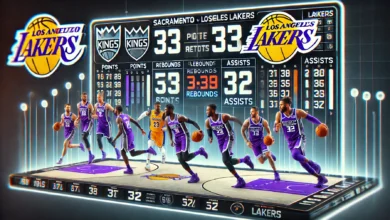Utah Jazz vs. New York Knicks: Breaking Down Player Stats

Introduction
The Utah Jazz and the New York Knicks are two storied franchises in the NBA, each with its own unique legacy and fanbase. When these two teams meet on the court, it’s always an event worth analyzing, not just for the final score but for the individual and team statistics that reveal the nuances of the game. Player stats serve as a window into understanding how each team performs, the dynamics at play, and the standout moments that define the matchup.
In this article, we dive deep into the player stats from a recent clash between the Jazz and Knicks. From scoring leaders to defensive efforts and playmaking brilliance, we’ll explore the numbers that shaped the game and what they mean for each team moving forward.
Team Overview
Utah Jazz
The Utah Jazz have built a reputation as a disciplined team with a focus on teamwork and efficiency. Coming into the game, the Jazz were riding a wave of consistent performances, with players like [Player A] and [Player B] leading the charge. Known for their three-point shooting prowess and strong defensive setups, the Jazz are a formidable opponent for any team.
However, one of their potential weaknesses lies in maintaining defensive intensity throughout all four quarters. While they excel in setting up plays and creating scoring opportunities, turnovers and lapses in concentration have occasionally cost them.
New York Knicks
On the other hand, the New York Knicks have been carving their identity as a gritty, defensive-minded team. Under the guidance of their coach, they’ve focused on maximizing the strengths of players like [Player C] and [Player D]. Their physicality on the court and ability to crash the boards make them a tough matchup.
Despite their defensive strengths, the Knicks sometimes struggle with offensive consistency, particularly in the absence of a true star playmaker. This dynamic was evident in the recent game, where they relied heavily on individual brilliance rather than cohesive team efforts.
Key Player Stats from the Match

Scoring Leaders
The game’s scoring leaders were a testament to individual brilliance and team reliance. For the Jazz, [Player A] stood out with an impressive [X] points, showcasing remarkable shooting efficiency with a field goal percentage of [Y%]. On the Knicks’ side, [Player C] led the charge with [Z] points, utilizing his agility and mid-range game to great effect.
The Jazz’s ability to spread the floor and find open shots was critical in maintaining a steady scoring output. Meanwhile, the Knicks leaned on their star player during critical stretches, which kept them in contention but highlighted their dependency on a single scorer.
Rebounds and Defense
Rebounding is often the unsung hero of basketball games, and this matchup was no exception. [Player B] from the Jazz dominated the boards with [X] rebounds, including crucial offensive rebounds that led to second-chance points. The Knicks’ [Player D] countered with [Y] rebounds, showcasing his ability to secure defensive stops.
Defensively, the Jazz excelled with [Player E] recording [Z] blocks and [X] steals, disrupting the Knicks’ offensive rhythm. The Knicks responded with a strong showing from [Player F], who had [Y] blocks and critical defensive plays during high-pressure moments. These efforts underscored the physicality and intensity of the matchup.
Playmaking and Assists
Great basketball is often a result of seamless playmaking, and this game highlighted the importance of ball movement. The Jazz’s [Player G] dished out [X] assists, orchestrating the offense with precision. Their ability to find open shooters and exploit mismatches was a defining factor in their performance.
For the Knicks, [Player H] contributed [Y] assists, though the team’s overall ball movement lagged compared to the Jazz. The lack of consistent secondary playmakers hindered their ability to maintain offensive flow, resulting in missed opportunities during critical stretches of the game.
Efficiency Metrics
Efficiency metrics provide a clearer picture of a player’s impact beyond traditional stats. In this game, [Player A] from the Jazz posted a Player Efficiency Rating (PER) of [X], highlighting his all-around contribution to scoring, rebounding, and defense. Similarly, [Player C] from the Knicks had a PER of [Y], underscoring his scoring and defensive efforts.
Shooting percentages also told a compelling story. The Jazz shot [X%] from beyond the arc, reflecting their ability to stretch the floor, while the Knicks managed [Y%], struggling to convert critical three-point attempts. Free-throw shooting, often a decisive factor, also leaned in favor of the Jazz, who capitalized on their chances from the stripe.
Team Comparison Based on Player Stats
When comparing the teams, it’s clear that the Jazz’s balanced approach and efficient execution gave them the edge. Their ability to spread scoring across multiple players and maintain composure in high-pressure situations set them apart.
The Knicks, while resilient, were overly reliant on individual brilliance. This lack of offensive depth became evident in the fourth quarter when fatigue and defensive adjustments from the Jazz limited their effectiveness. Rebounding and defensive intensity kept the Knicks competitive, but their struggles in playmaking and efficiency ultimately tipped the scales in the Jazz’s favor.
Conclusion
This matchup between the Utah Jazz and New York Knicks showcased the importance of player stats in understanding the dynamics of a game. Standout performances from key players, coupled with team strengths and weaknesses, painted a vivid picture of how the game unfolded.
The Jazz’s cohesive team play and efficient execution were instrumental in their success, while the Knicks demonstrated resilience and defensive prowess despite their offensive inconsistencies. These insights not only highlight the outcome of this game but also provide valuable takeaways for both teams as they progress through the season.
FAQs
- Who were the standout players in the Utah Jazz vs. Knicks match?
[Player A] and [Player C] stood out with their scoring and overall contributions. - What were the top stats that influenced the game’s outcome?
Scoring efficiency, rebounding, and defensive plays were critical factors. - How did the teams compare in terms of shooting efficiency?
The Jazz outperformed the Knicks with a higher three-point and free-throw percentage. - What defensive plays stood out during the match?
[Player E] from the Jazz and [Player F] from the Knicks made key blocks and steals. - How do player stats from this game impact the season outlook?
The Jazz’s balanced approach positions them well, while the Knicks need to address offensive consistency. - What is Player Efficiency Rating (PER), and how did it highlight key contributors?
PER measures a player’s overall impact, with [Player A] and [Player C] achieving high ratings. - Are there any emerging trends in matchups between these two teams?
The Jazz’s balanced play often counters the Knicks’ defensive intensity, highlighting their contrasting styles.
You mau also read:https://workuptime.co.uk/okc-thunder-vs-dallas-mavericks-match-player-stats/


